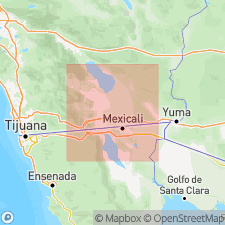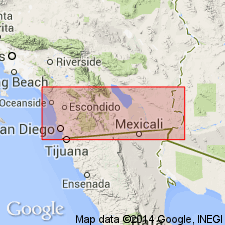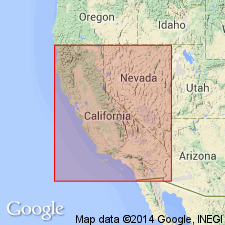
- Usage in publication:
-
- Anza Formation
- Modifications:
-
- Areal extent
- Dominant lithology:
-
- Conglomerate
- AAPG geologic province:
-
- Salton basin
Summary:
Pg. 911-913. Anza Formation. Comprises about 1,100 feet of reddish granitic conglomerate with massive wedges of arkose. Underlies Split Mountain Formation. Overlies basement complex. [Age is considered Miocene.]
Name credited to Woodard [1963 Univ. California, Berkeley, unpub. dissert.].
Source: US geologic names lexicon (USGS Bull. 1350, p. 29); GNU records (USGS DDS-6; Menlo GNULEX).

- Usage in publication:
-
- Anza Conglomerate
- Modifications:
-
- Principal reference
- Dominant lithology:
-
- Fanglomerate
- Sandstone
- AAPG geologic province:
-
- Salton basin
Summary:
Anza Formation. Formerly referred to as basal [red] member of Split Mountain Formation. Consists of reddish-brown granitic fanglomerate and arenite strata. In type area, thickness about 1,800 feet. Underlies Split Mountain Formation (restricted). Age is Miocene.
Type area: Split Mountain gorge in Vallecito area, Imperial Valley, southern CA.
Source: US geologic names lexicon (USGS Bull. 1350, p. 29); GNU records (USGS DDS-6; Menlo GNULEX).
- Usage in publication:
-
- Anza Formation
- Modifications:
-
- Principal reference
- Dominant lithology:
-
- Fanglomerate
- Sandstone
- AAPG geologic province:
-
- Salton basin
Woodard, G.D., 1974, Redefinition of Cenozoic stratigraphic column in Split Mountain gorge, Imperial Valley, California: American Association of Petroleum Geologists Bulletin, v. 58, no. 3, p. 521-539.
Summary:
Pg. 522-523. Anza Formation. Rocks previously referred to as basal [red] member of Split Mountain Formation. Consists of reddish-brown, coarse to very coarse, moderately to well-indurated, massive and cross-bedded arkosic sandstone, with interbedded gray, cobble and boulder, granitic fanglomerate derived from local source areas. Percentage of conglomerate increases markedly in upper section. [In fig. 2 (p. 522) the Anza is subdivided into upper and lower members.] Thickness 1,800 feet (540 m). Conformably underlies Split Mountain Formation (restricted), and in places, unconformably underlies Alverson Andesite. Unconformably overlies pre-Cenozoic granitic and metamorphic rocks. Recognized in southwestern Imperial Valley, in the Fish Creek Mountains, Coyote Mountains, [Imperial and San Diego Counties, southern California], and along eastern Peninsular Range. Age is Miocene.
Type locality: Split Mountain gorge, in secs. 25 and 36, T. 13 S., R. 8 E., Borrego Mountain SE 7.5-min quadrangle, [San Diego Co.], southern CA. Named from Anza-Borrego Desert State Park, the bdry. of which lies 0.5 mi (0.8 km) east of Split Mountain gorge.
Source: Publication.

- Usage in publication:
-
- Anza Formation
- Modifications:
-
- Geochronologic dating
- AAPG geologic province:
-
- Salton basin
Summary:
Anza Formation. Oldest Cenozoic unit in Vallecito, Fish Creek, Coyote Mountains, and Borrego Valley, southern California. Lies nonconformably on pre-Cenozoic basement rocks. K-Ar age determinations on interbedded andesite (Gastil, Krummenacher and Minch, 1979) indicate Anza is in part about 18 Ma and older than the overlying Alverson Andesite (16.0 +/-1 Ma). [Miocene.]
Source: Modified from GNU records (USGS DDS-6; Menlo GNULEX).
For more information, please contact Nancy Stamm, Geologic Names Committee Secretary.
Asterisk (*) indicates published by U.S. Geological Survey authors.
"No current usage" (†) implies that a name has been abandoned or has fallen into disuse. Former usage and, if known, replacement name given in parentheses ( ).
Slash (/) indicates name conflicts with nomenclatural guidelines (CSN, 1933; ACSN, 1961, 1970; NACSN, 1983, 2005, 2021). May be explained within brackets ([ ]).

